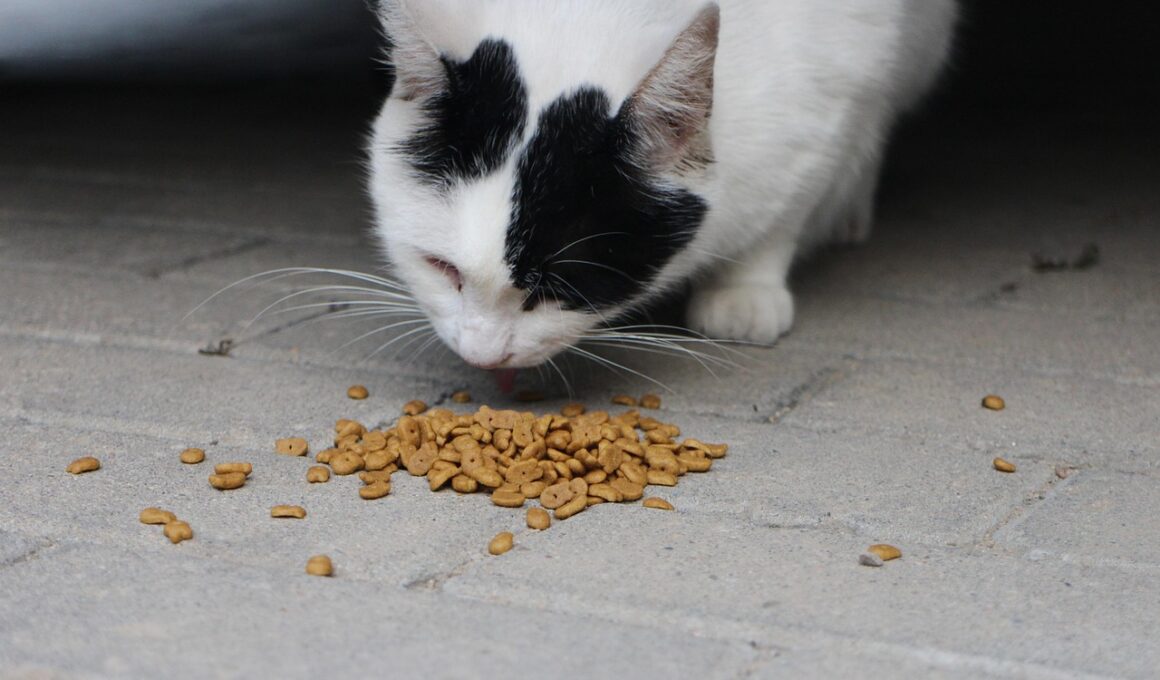Changes in Eating Habits Linked to Obsessive-Compulsive Behaviors in Cats
Understanding changes in eating habits in cats can reveal underlying obsessive-compulsive behaviors that may disrupt their mental health. Cats that exhibit compulsive behaviors often show marked alterations in their routines. One major sign to consider is whether your cat exhibits unusual eating patterns, such as consuming food excessively or refusing to eat altogether. This change could be an indication of stress or anxiety, often stemming from environmental factors or changes in their routine. As pet owners, it’s crucial to recognize that our furry friends may not verbalize discomfort but communicate it through their actions. When observing these patterns, consider keeping a detailed log of their eating habits and changes in behavior. Monitoring this can help your veterinarian identify potential issues better. These behaviors could lead to more significant health problems if not addressed. Understanding the difference between typical picky eating and changes tied to compulsivity is vital. Owners should consult with a vet skilled in behavioral issues to evaluate these changes accurately, ensuring their beloved pet receives the best care possible.
Additional signs of obsessive-compulsive behaviors in cats often manifest alongside changes in eating habits. While many cats are known for their unique quirks, some behaviors can hint at deeper issues. For instance, if your feline friend repetitively grooms itself to the point of skin irritation, it may signal anxiety or stress, potentially linked to their eating behavior. This cyclical relationship between feeding and compulsive actions can escalate, wherein distress caused by changes in diet leads to increased grooming and vice versa. It’s essential for pet owners to watch for these intertwined patterns. Another important observation is the reluctance to try new foods, sometimes deflecting to familiar options due to anxiety. Consulting with a veterinarian who specializes in feline behavior is imperative to distinguish between simple pickiness and true compulsive tendencies. They may suggest dietary changes or behavioral therapy. Keeping your cat’s environment stable and low-stress is paramount, and incorporating mindfulness into feeding routines can make a significant difference. Solutions such as puzzle feeders can help alleviate stress and positively engage your cat’s mind, promoting healthier eating habits.
Cats may also develop rituals surrounding their feeding time, which can signal an obsessive-compulsive behavioral pattern. For instance, some may stare at their food bowl for an extended duration before eating, or develop a precise routine that must be followed, like pacing in a specific way before acting on hunger. Such actions indicate an unhealthy fixation on the act of eating. This obsession may lead to stress and frustration if their patterns are disturbed. Owners should take note if any delivery or serving interruptions unsettle their cats. Understanding this aspect means being observant of your cat’s behavior as you transition from one feeding schedule to another. Keeping the same routine consistently is essential. Moreover, it’s advisable to avoid dramatic changes to their environment or diet, as these can greatly exacerbate stress. Gradual adjustments can be beneficial, allowing cats the time to acclimatize. Utilizing calming products such as pheromone diffusers can ease anxiety related to disrupted habits. Engaging your cat through play immediately after feeding can also shift their focus, encouraging positive behavior relating to meals.
The Role of Environmental Factors
The environment plays a crucial role in a cat’s eating habits and overall behavior, particularly concerning obsessive-compulsive tendencies. Cats are creatures of habit, and any alterations in their surroundings might provoke anxiety. A new household member, a relocation, or even the introduction of unfamiliar furniture can disrupt their routine. It’s essential to ensure that your cat’s environment remains stable and soothing. Providing enriched spaces with familiar scents and secure hiding spots can help minimize stress. Specific furnishings like tall scratching posts and interactive toys can further promote positive engagement and divert their attention from obsessive behaviors. Additionally, maintaining a consistent cleaning regimen around their feeding areas can create a calm atmosphere. Consider using calming music or nature sounds to facilitate relaxation during mealtime. These subtle shifts in environment can lead to positive changes in eating habits while also enhancing their mental well-being. Owners should engage in ongoing observation to catch these environmental triggers early. Initiating a calming and consistent atmosphere reduces the chance of issues arising from compulsive patterns, creating a more harmonious living space for both you and your cat.
A dedicated approach to addressing compulsive eating behaviors in cats requires immersive strategies. Redirecting focus during feeding may create a more engaging experience for your feline. Introducing playtime right before meals can serve to buffer high energy levels and distract them from compulsive tendencies. By pairing physical activity with feeding, cats can develop healthier attitudes toward eating rather than fixating obsessively on their bowls. Moreover, the gradual introduction of variations in food types and textures can prevent food fixation. This approach allows them to explore their preferences without developing a compulsion towards specific items. Offering various feeding locations or utilizing interactive feeders can tap into their natural instincts while also encouraging more mindful eating. Consistency is key; rotations in food and feeding locations should happen gradually. Be cautious of abrupt shifts that may elevate anxiety. Consulting with professionals can provide valuable guidance. Working alongside a veterinarian ensures that behavioral strategies align with nutritional needs. With patience and strategic intervention, your cat’s eating habits can shift toward healthier patterns, ultimately improving their mental health.
Seeking Professional Help
When deteriorating eating habits and compulsive behaviors persist in your cat, seeking professional help should be a priority. Proper intervention begins with a comprehensive evaluation by a veterinarian who understands feline behavioral issues. These professionals can provide recommendations tailored specifically for your cat. The initial consultation often includes a thorough assessment of your pet’s health and any changes in their environment that could contribute to their behavior. Based on findings, veterinarians may recommend therapies such as cognitive behavioral therapy or even medication to assist in alleviating anxiety. Through consistent follow-ups, observations can be streamlined, identifying factors that influence your cat’s health outcomes. Owners are encouraged to document any noted progress or setbacks while following the vet’s guidance. This active engagement is vital for ensuring healing and improvement. Fostering a sense of partnership with your veterinarian can facilitate a supportive pathway to recovery, improving your cat’s quality of life. Furthermore, creating an ongoing routine for check-ups can assist in averting potential issues from escalating. With thorough care and attention, pet owners can manage their cat’s compulsive tendencies, leading to a more balanced emotional state.
Finally, staying proactive in maintaining positive mental health for your cat is essential. Regular check-ins with your vet about their eating habits will ensure that any concerning changes are addressed promptly. Moreover, dedicating time to engage with your cat can foster emotional well-being and help stave off potential compulsive behaviors. Investing in quality playtime and ensuring mental stimulation is critical, given that bored cats may manifest compulsive eating as a response. Incorporating environmental enrichment, such as cat trees or climbing shelves, can also enhance their overall mental health. Providing an array of toys that promote hunting or problem-solving can reinforce positive behaviors as they navigate their surroundings. Moreover, ensuring the litter box and feeding area is clean can help create a comforting environment, reducing anxiety correlated with those areas. Remember, the objective is to ensure your cat finds comfort in their routine while allowing for gradual adjustments. By implementing these strategies and maintaining an open line of communication with your veterinarian, you can help your cat foster healthier habits, leading to a happier, healthier life.
In Conclusion
Recognizing signs of obsessive-compulsive behavior in cats and linking them to changes in eating habits is crucial for their overall well-being. Paying attention to your cat’s behavior offers insight into their emotional state. Changes in eating routines could lead to more significant health problems if lacking attention. By understanding the environmental triggers and behavioral aspects connected to their eating, adjustments can be made to ease stress levels. Consulting with professionals when signs appear will help ensure the best therapeutic approaches. Taking a proactive stance in pet care fosters an environment where mental health can flourish. Ultimately, fostering positive behavioral patterns leads to a healthier cat that experiences less anxiety and stress, allowing them to thrive in a comfortable setting. Owners are encouraged to invest in creating a stable environment, establishing routines, and engaging regularly with their pets. Armed with this knowledge, owners can become more adept at recognizing critical signs early. By staying vigilant and proactive about your cat’s health and behavior, you promote a happier life for your furry friend, creating a loving and fulfilling environment for both.


